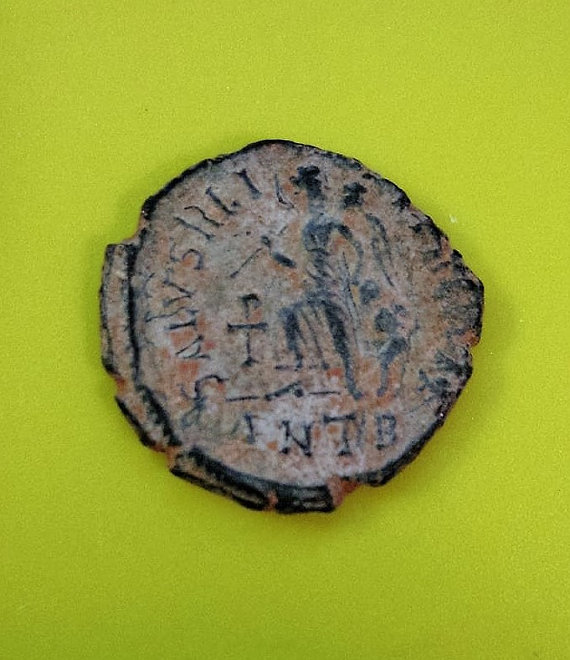Clio’s featured object this week is a very small and inexpensive bronze coin dating from Late Antiquity; specifically the reign of Theodosius I (sometimes referred to as Theodosius the Great). The coin is in remarkably good condition with very clear imagery and text.
Before examining the context and significance of this coin, let’s review the details of the object itself. The obverse features a rather stylized pearl diademed, draped and cuirassed bust of Theodosius facing right, with a fairly standard Latin inscription: DN THEODO-SIVS PF AV is an abbreviated form of “Our Lord Theodosius, the dutiful, the fortunate, Augustus.” The reverse features a winged figure of Victory advancing left, a military trophy over one shoulder, dragging a captive behind her, with another fairly standard late Roman Latin inscription: SALVS REI-PVBLICAE, roughly meaning “Health of the Republic.” In the left field is the early Christian symbol comprised of the Greek letters Chi and Rho, a monogram for Christ. A mintmark, beneath the ground line, shows the coin was struck at the Antioch mint. Antioch was capitol of the Roman province of Syria and is today in the territory of Turkey. The coin measures just 14 mm and weighs a mere 1.35 grams. Its pinkish color is sometimes referred to as a desert patina, indicating burial in dry soil with a high iron content.

The Emperor in whose name this coin was struck was certainly one of the most determined and forceful men of action in Roman history. He could be diplomatic and conciliatory one day, brutal and unforgiving the next. Theodosius came to power following the disastrous defeat of a large Roman field army at the hands of a combined force of Visigoths and Alans, in the Province of Thrace in 378 AD. The Emperor Valens, along with two thirds of his army, perished, leaving only Gratian ruling in the West. Needing a co-ruler, he selected an officer from the province of Iberia (Spain), Flavius Theodosius, to rule in the East and deal with the Goths who were now marauding virtually unchecked through the Balkans.
Once in power, Theodosius decisively defeated two usurpers in the west and, after a grinding four year war with the Goths and their allies, came to a peace agreement that allowed them to settle within the Empire, provided they served as military allies when called. But he is perhaps best known to history for having made the final break with Rome’s ancient “pagan” religious past. In 391 he issued an edict forbidding pagan worship and closing all pagan temples. The dynastic line he founded would come to an end about fifty years later, marking the final split between the rapidly dissolving Western Roman Empire and the Eastern Roman Empire, known to us today as the Byzantine Empire.
For an excellent study of this important Roman Emperor, as well as a thoughtful examination of the Battle of Hadrianopolis and its long term implications for the Western Roman Empire, we recommend the following work: Theodosius: The Empire at Bay by Gerard Friell and Stephen Williams, 1995, Yale University Press.
For those interested acquiring this coin, it may be found on our Etsy site, here: https://www.etsy.com/listing/265233500/roman-empire-bronze-ae-4-of-theodosius-i?ref=shop_home_active_16 and on our eBay site here: http://m.ebay.com/itm/Roman-Empire-Bronze-AE-4-of-Theodosius-I-AD-383-392-Extremely-Fine-/131843167047?nav=SELLING_ACTIVE

